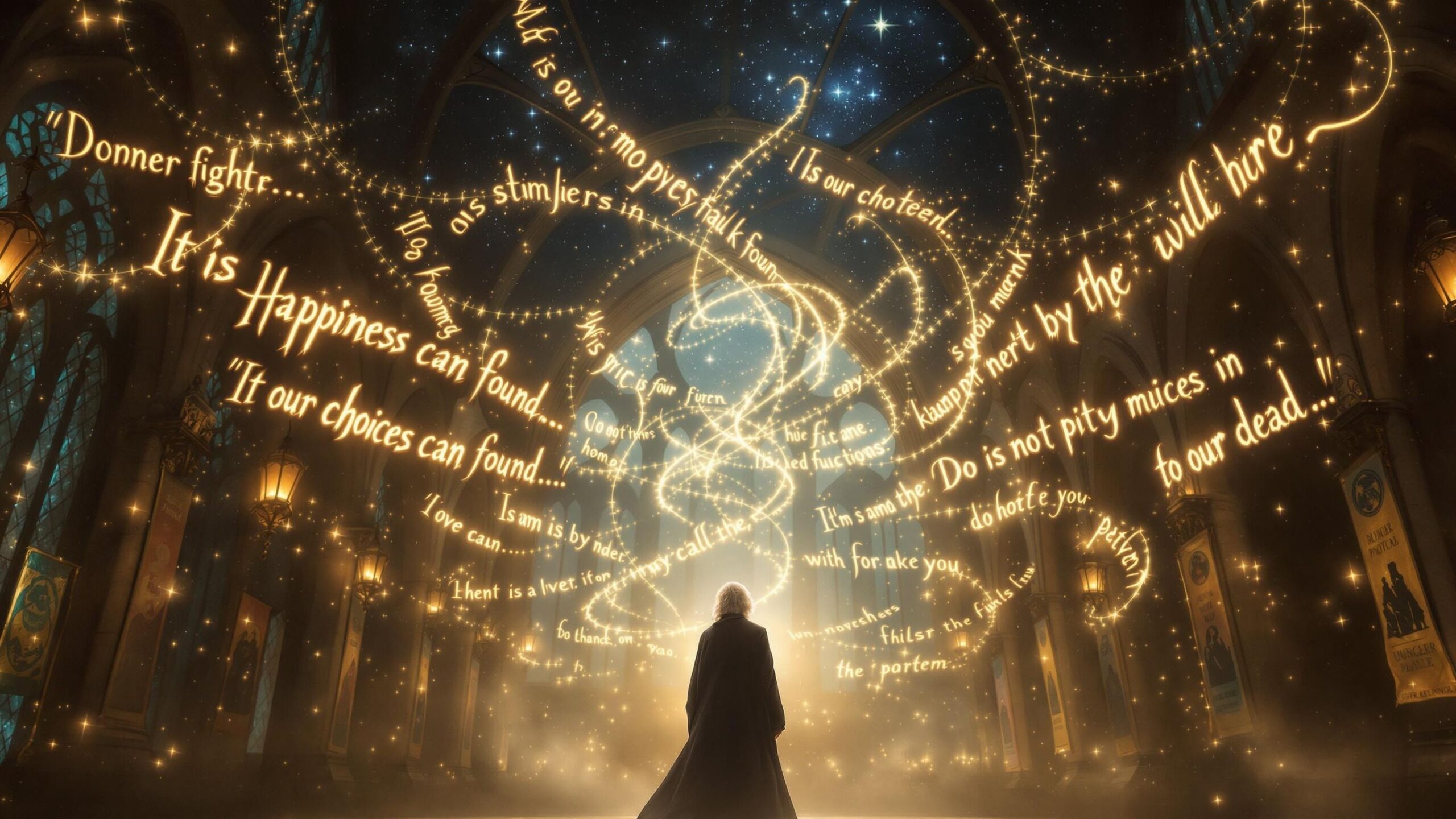In the wizarding world, magic is a powerful tool—but like any tool, it can be used for creation or destruction. Nowhere is this more evident than in the realm of curses. Unlike hexes or jinxes, curses are designed with one goal in mind: to harm, control, or even kill. From spells whispered in shadows to those banned by the Ministry, the Harry Potter universe is filled with dark enchantments that send shivers down the spine of even the bravest witches and wizards. Feared for their irreversible damage, emotional torment, and sheer cruelty, these curses are not just dangerous—they’re infamous. Here are the top ten most feared curses in the magical world, each one leaving a trail of fear, pain, and devastation in its wake.
#10: The Entrail-Expelling Curse
While not as widely known to casual fans, the Entrail-Expelling Curse is considered one of the most gruesome spells in dark magical history. As the name suggests, it violently ejects the internal organs of its victim—a detail horrifying enough that the spell is rarely spoken of, even among dark wizards. First mentioned in historical contexts related to medieval magical warfare, the curse was famously used by a dark witch named Urquhart Rackharrow, who reportedly pioneered it at St. Mungo’s Hospital centuries ago earning both infamy and a wing of the hospital named after him for research into repairing its effects. The Entrail-Expelling Curse embodies the vicious, twisted nature of ancient dark magic. It’s not just lethal—it’s an act of magical sadism. Its reputation lingers in whispers and ancient scrolls, a relic of a time when curses were designed not just to kill, but to mutilate. It ranks among the most feared for the sheer horror it inflicts on the human body, and the lingering trauma left in its wake.
#9: The Tongue-Tying Curse
This deceptively simple but psychologically tormenting curse is often used by powerful wizards to control what others can say—especially in situations involving secrecy or betrayal. While not as flashy as a killing spell, the Tongue-Tying Curse can prevent a witch or wizard from speaking certain names, revealing critical information, or even forming coherent sentences when trying to talk about a protected subject. Snape uses a variant of this on Wormtail, and it is implied that Voldemort employed it liberally to keep Death Eaters silent about key plans. What makes it especially sinister is that it acts directly on the target’s free will, restricting speech, memory, or thought. The idea of being magically gagged, unable to warn others or explain yourself, is a chilling form of suppression. While not always used with lethal intent, the Tongue-Tying Curse represents a form of magical control that is deeply feared—not just for its effects, but for the message it sends: your voice is not your own.
#8: The Sectumsempra Curse
Invented by Severus Snape during his time as a Hogwarts student, Sectumsempra is one of the most dangerous curses ever created by a teenager. Designed to slice and maim the target as if attacked by an invisible sword, this spell causes deep, bleeding wounds that appear instantly upon impact. When Harry uses it on Draco Malfoy in Half-Blood Prince, he’s horrified by the brutal results—Draco collapses, bleeding out on the bathroom floor, and requires emergency magical healing from Snape himself. What makes Sectumsempra particularly feared is its stealthy nature. It doesn’t produce a flashy burst of light or sound, which makes it even more deadly in close combat. It’s not a duel-ending curse—it’s a life-ending one. Snape may have created it in secret, but its legacy was forged in blood. The idea that a single, quiet incantation can cut someone down without warning adds to its terrifying mystique in dueling circles and among dark magic researchers.
#7: The Inferius Curse
The creation of an Inferius isn’t a single incantation, but a complex form of dark necromancy that animates a corpse to do the bidding of a dark wizard. These creatures, cold and soulless, are immune to most spells and attack with mindless violence. Voldemort used Inferi to guard the Horcrux hidden in the cave, surrounding it with a lake of the undead ready to drag intruders to their deaths. The Inferius Curse is feared not just for its power, but for what it symbolizes: the violation of death. It robs people of their dignity after death, desecrating their bodies and turning them into weapons. Unlike ghosts or spirits, Inferi have no personality, no humanity—they are pure tools of fear. To fight one is horrifying; to be surrounded by dozens is nightmare fuel. The magical community considers this one of the darkest forms of magic, and for good reason—raising the dead to kill the living crosses a line few dare approach.
#6: The Cruciatus Curse (Crucio)
One of the three Unforgivable Curses, Crucio is designed for one purpose: to cause unbearable, mind-shattering pain without leaving a physical mark. It is used as a tool of torture, often to extract information or simply for sadistic pleasure. Bellatrix Lestrange famously used it on Frank and Alice Longbottom, reducing them to a permanent state of insanity. The key to casting it effectively lies in intent—you must genuinely want to cause suffering. That requirement alone makes this curse especially disturbing. Unlike spells that attack the body, Crucio targets the mind, overwhelming the victim’s nervous system and sense of self. It is used liberally by Death Eaters, and even Harry attempts it during Deathly Hallows, though he lacks the deep hatred to cast it effectively. To be hit by Crucio is to experience suffering beyond comprehension—and to use it is to embrace the darkest parts of the soul. It is feared not just for what it does, but for what it requires of the caster.
#5: The Imperius Curse (Imperio)
Another of the Unforgivable Curses, the Imperius Curse strips its target of free will entirely. With a simple incantation, the caster can force someone to obey any command, no matter how dangerous, humiliating, or morally corrupt. Victims under the Imperius Curse often appear blissfully calm—further deepening its chilling effect. Used heavily during Voldemort’s reign, many witches and wizards claimed to have acted under its influence to avoid punishment, making it a central tool of manipulation and control. What makes Imperio so terrifying is not just its power, but the subtlety of its violence. A person under Imperius can be made to betray friends, commit murder, or even take their own life—all while smiling. It removes choice, the very thing that defines a person. Few curses are as violating. Its long-term effects on the psyche are not well understood, but the trauma of realizing one’s actions were not their own leaves a lasting scar. This curse doesn’t just take control—it erases identity.
#4: The Fidelius Curse (inverted use)
While typically used to hide secrets and protect locations like the Potters’ home in Godric’s Hollow, the Fidelius Charm becomes darkly feared when abused. The spell binds a secret to a single individual—the Secret-Keeper—making it accessible only to them and those they choose to share it with. In principle, it’s a protective measure. But when the Secret-Keeper turns traitor, the charm becomes a weapon. Peter Pettigrew’s betrayal of the Potters is a prime example of how the spell’s trust-dependent nature can backfire with deadly consequences. The horror of the Fidelius Charm lies in how it weaponizes trust. When cast with ill intent, it isolates people from help and makes betrayal almost invisible. Its use in this inverted form highlights how even well-meaning magic can become fearsome when manipulated by the wrong hands. It’s not the spell itself that is evil—it’s what it allows people to do when loyalty fails.
#3: The Blood Quill Curse
One of the most sinister curses disguised as a punishment is the Blood Quill, used by Dolores Umbridge in Order of the Phoenix. Unlike traditional curses, it’s embedded in an object rather than cast in battle. When used, the Blood Quill forces the user to write lines with their own blood—carving the words into the back of their hand while writing them with unnatural precision. What’s terrifying is that it causes lasting pain, physical scarring, and psychological trauma, yet leaves little evidence to those unaware of its dark properties. It’s a silent torture tool wrapped in educational discipline, which makes it all the more horrifying. It turns detention into abuse and school discipline into cruelty, normalizing pain under the guise of authority. The fact that the Ministry allowed Umbridge to use it highlights how evil can fester within systems, and how dark magic doesn’t always scream—it whispers. It’s feared for the insidious way it cloaks darkness in respectability.
#2: The Killing Curse (Avada Kedavra)
No curse is more final or more feared than Avada Kedavra. Known as the Killing Curse, it causes instant, painless death and is virtually unblockable. There’s no counter-curse, no healing spell, and no wandwork that can deflect it—except for the rarest of magical anomalies. Voldemort’s use of it throughout the series solidified its place in magical infamy. This curse does not wound or maim—it simply ends life, in a flash of green light and silence. The only known survivor of this spell is Harry Potter, due to the magical protection from his mother’s sacrificial love. That anomaly aside, it is an executioner’s curse, used by dark wizards who want to kill without conflict. Casting it requires powerful magical ability and a complete disregard for life. Its reputation is so chilling that even saying its name aloud causes discomfort. Avada Kedavra is the epitome of magical lethality—final, merciless, and forbidden.
#1: The Horcrux Curse
The darkest curse in the wizarding world isn’t a single spell—it’s the magical process used to create a Horcrux. This requires not only the murder of an innocent, but also the splitting of the soul—an act so vile that it damages the very essence of the caster. To create a Horcrux is to twist nature itself, anchoring a fragment of one’s soul into an object to avoid death. The ritual is shrouded in secrecy, described as the most “terrible piece of dark magic” by Horace Slughorn. Its consequences are immense: emotional detachment, physical transformation, and eventual madness. Voldemort created seven Horcruxes, each one further distancing him from humanity. The very act of making a Horcrux is a curse upon the soul, causing irreversible spiritual mutilation. It is feared not only for its mechanics, but for what it reveals about the person who performs it. It doesn’t just kill—it corrupts. That’s why the Horcrux Curse stands as the most feared form of dark magic in existence.
Curses in the wizarding world are more than just dangerous spells—they are reflections of intention, power, and the darkness that can live within even the most gifted magic users. From mind-controlling enchantments to soul-splitting rituals, these ten curses represent the most feared and devastating aspects of magical warfare. While powerful wizards can duel and defend, curses often bypass even the strongest protections by attacking the mind, body, or spirit directly. Some kill instantly, others leave scars that never heal. But all remind us of a chilling truth: magic, in the wrong hands, can become a weapon of unspeakable horror. The most terrifying spells aren’t just the loudest or deadliest—they’re the ones that rob you of control, identity, or hope.




